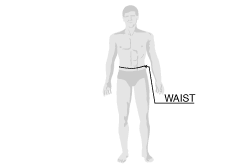Nov 26, 2024
Men's Swim Suits
From competitive to fitness suits, here's advice for choosing the right style, materials, and fit.
How to Buy Men's Swimsuits
For competitive swimming as well as aquatic fitness activities, such as lap swimming and water aerobics, a good swimsuit will increase your efficiency in the water, keep you feeling comfortable during your activity, and stand up better to the deteriorating effects of chlorinated water than most fashion swimsuits.
Determine Your Size
To determine your swimsuit size, you'll need to measure yourself using a tape measure.
Measuring Tips
- Take your measurements while wearing only your underwear
- Stand in front of a mirror
- While measuring, make sure that the tape measure is straight, not twisted
- To get an accurate measurement, the tape measure should be snug, but not pinching or tight
Step-by-Step Measuring Guide
- Find your natural waistline by bending to one side. While standing straight, measure around your waistline
- Men should measure just above the hipbone (or about an inch below your natural waistline) to determine the appropriate swimsuit size

Find Your Size
- If you are between sizes, choose the smaller size in a racing/competition suit and the larger size in an aquatic fitness suit
- Most men's suits are sized based on waist measurement. Men should choose the size that corresponds with their waist measurements.

Racing/Competitive Swimming
- For both training and competition, competitive swimmers need high-performance suits that maximize speed in the water and improve glide timesby reducing drag and increasing water flow.
- Many swimmers buy separate suits for training and competition. For both training and competition, compression, resulting in a tight fit, is the key.
Sizing
- For training, buy your normal size, but realize that the fit will be snugger than that of a regular fashion swimsuit
- For competition, consider buying a suit at least one size smaller than your training suit
Construction
- Support
- Swimsuits for both training and competition support through compression
- Lining
- Suits for top-level competition are not lined, since reducing drag is a priority. However, many men's suits for training are front-lined.
- A suit with lining will generally last longer, and hold its shape and color better than an unlined suit
Styling
- Men's competition and training suits have moderately cut leg openings, drawcords in the interior of the waistband, and side seams of about 3-inches
- For men wanting more coverage, training suits with lower leg openings and side seams up to seven-inches are available, but they are not the norm for training or competition
Fabrication
- Although there are many hybrid fabrics for racing/competitive swimming available, most swimsuits for this sport are done in blends of nylon/spandex. (Lycra is a specific brand of spandex made by DuPont and is found in many swimsuits.)
- Improvements in fiber engineering have resulted in swimsuit materials that are more resistant to chlorine than ever. Suits for racing/competitive swimming typically use these more durable versions of nylon and spandex.
Aquatic Fitness
- For lap swimming and water aerobics, you will need a suit that provides comfort and freedom of movement, plus coverage and support
- Men will find training suits designed for the competitive swimmer to be most appropriate for lap swimming for fitness
- Fit should be snug but not tight. A good fitting suit will stay in place during vigorous movement, but not pinch, bind or ride up in the seat.
When to Replace Your Swimsuit
- Despite the advances in fiber technology, chlorine will eventually deteriorate swimsuit fabrics. When your suit begins to bag or feels looser than when it was new, it is time to replace your suit.